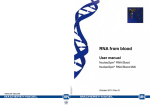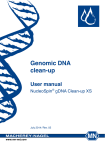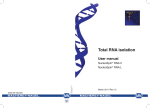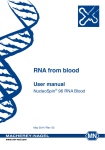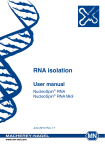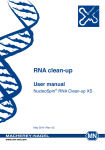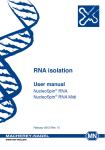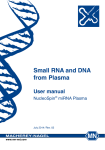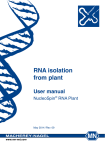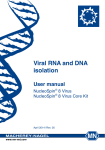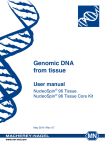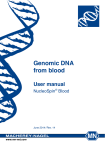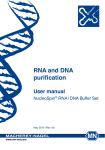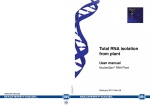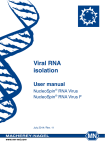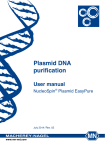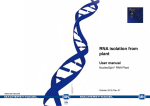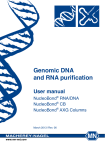Download NucleoSpin® RNA Blood - MACHEREY
Transcript
RNA from blood User manual NucleoSpin® RNA Blood NucleoSpin® RNA Blood Midi May 2014 / Rev. 03 RNA from blood Protocol-at-a-glance (Rev. 03) 1 Lyse blood Mini Mini Midi NucleoSpin® RNA Blood NucleoSpin® RNA Blood NucleoSpin® RNA Blood Midi 200 μL blood 400 μL blood 1.3 mL blood 200 μL blood 200 μL DL 400 μL blood 400 μL DL 1.3 mL blood 1.3 mL DL 5 μL Pro. K 10 μL Pro. K 33 μL Pro. K Mix 2 Adjust RNA binding conditions Mix Mix RT, 3–15 min (shaking) RT, 3–15 min (shaking) RT, 3–15 min (shaking) 200 μL 70 % ethanol Mix 400 μL 70 % ethanol Mix 1.3 mL 70 % ethanol Mix Load sample Load sample stepwise Load sample 11,000 x g, 30 s 11,000 x g, 30 s 4,500 x g, 3 min 350 μL MDB 350 μL MDB 11,000 x g, 30 s 11,000 x g, 30 s 4,500 x g, 3 min 95 μL rDNase 95 μL rDNase 240 μL rDNase RT, 15 min RT, 15 min RT, 15 min 3 Bind RNA 4 Desalt silica membrane 5 Digest DNA 6 Wash silica membrane 1st and 2nd wash 3rd wash 1.2 mL MDB 200 μL RB2 200 μL RB2 1 mL RB2 600 μL RB3 600 μL RB3 3 mL RB3 250 μL RB3 250 μL RB3 11,000 x g, 30 s 11,000 x g, 30 s 11,000 x g, 2 min 11,000 x g, 2 min 60 μL RNasefree H2O 60 μL RNasefree H2O 200 μL RNasefree H2O 11,000 x g, 30 s 11,000 x g, 30 s 4,500 x g, 3 min 4,500 x g, 3 min 7 Elute RNA MACHEREY-NAGEL GmbH & Co. KG · Neumann-Neander-Str. 6–8 · 52355 Düren · Germany Tel.: +49 24 21 969-270 · Fax: +49 24 21 969-199 · [email protected] · www.mn-net.com RNA from blood Table of contents 1 Components 4 1.1 Kit contents 4 1.2 Reagents, consumables, and equipment to be supplied by user 6 1.3 About this user manual 6 2 Product description 7 2.1 The basic principle 7 2.2 Kit specifications 8 2.3 Handling, preparation, and storage of starting materials 9 2.4 Elution procedures 10 3 Storage conditions and preparation of working solutions 11 4 Safety instructions 13 5NucleoSpin® RNA Blood protocols 15 5.1 RNA isolation from 200 μL blood 15 5.2 RNA isolation from 400 μL blood 18 6NucleoSpin® RNA Blood Midi protocol – RNA isolation from 1.3 mL blood 7Appendix 21 24 7.1 rDNase digestion in solution 24 7.2Troubleshooting 26 7.3 Ordering information 29 7.4 Product use restriction / warranty 30 MACHEREY-NAGEL – 05 / 2014, Rev. 03 3 RNA from blood 1 Components 1.1 Kit contents NucleoSpin® RNA Blood* 10 preps 50 preps 740200.10 740200.50 Lysis Buffer DL 25 mL 25 mL Wash Buffer RB2 13 mL 13 mL Wash Buffer RB3 (Concentrate)** 6 mL 12 mL Membrane Desalting Buffer MDB 10 mL 25 mL Reaction Buffer for rDNase 7 mL 7 mL 1 vial (size C) 2 vials (size D) Liquid Proteinase K 120 μL 600 μL RNase-free H2O 13 mL 13 mL NucleoSpin RNA Blood Columns (light blue rings - plus Collection Tubes) 10 50 Collection Tubes (2 mL, with lid) for lysis 10 50 Collection Tubes (1.5 mL) for elution 10 50 Collection Tubes (2 mL) 30 150 User manual 1 1 REF rDNase, RNase-free (lyophilized)** ® * Patent pending ** For preparation of working solutions and storage conditions see section 3. 4 MACHEREY-NAGEL – 05 / 2014, Rev. 03 RNA from blood 1.1 Kit contents continued NucleoSpin® RNA Blood Midi* 20 preps REF 740210.20 Lysis Buffer DL 50 mL Wash Buffer RB2 13 mL Wash Buffer RB3 (Concentrate)** 25 mL Membrane Desalting Buffer MDB 50 mL Reaction Buffer for rDNase 7 mL rDNase, RNase-free (lyophilized)** 2 vials (size D) Liquid Proteinase K 800 μL RNase-free H2O 13 mL NucleoSpin® RNA Blood Midi Columns (plus Collection Tubes) 20 Collection Tubes (15 mL) for lysis, elution, and washing steps 60 User manual 1 * Patent pending ** For preparation of working solutions and storage conditions see section 3. MACHEREY-NAGEL – 05 / 2014, Rev. 03 5 RNA from blood 1.2 Reagents, consumables, and equipment to be supplied by user Reagents • • 96–100 % ethanol (to prepare Wash Buffer RB3) 70 % ethanol (to adjust RNA binding conditions) Consumables • Sterile RNase-free tips Equipment • Manual pipettors • Centrifuge for microcentrifuge tubes (NucleoSpin® RNA Blood) • • • Vortex mixer Centrifuge for 15 mL tubes with a swing-out rotor capable of reaching 4,500 x g (NucleoSpin® RNA Blood Midi) Personal protection equipment (e.g., lab coat, gloves, goggles) 1.3 About this user manual It is strongly recommended to read the detailed protocol sections of this user manual if using the NucleoSpin® RNA Blood or NucleoSpin® RNA Blood Midi kits for the first time. However, experienced users may refer to the Protocol-at-a-glance. The Protocolat-a-glance is designed to be used only as a supplemental tool for quick referencing while performing the purification procedure. All technical literature is available on the internet at www.mn-net.com. 6 MACHEREY-NAGEL – 05 / 2014, Rev. 03 RNA from blood 2 Product description 2.1 The basic principle The NucleoSpin® RNA Blood kits offer a direct total blood lysis from 200–400 μL (NucleoSpin® RNA Blood) or 400–1300 μL (NucleoSpin® RNA Blood Midi) whole blood collected in standard (e.g., EDTA) blood collection tubes. One of the most important aspects in RNA purification is to prevent RNA degradation during the isolation. With the NucleoSpin® RNA Blood method, leukocytes (the main source of RNA in whole blood) and other blood cells, are lysed by incubating the whole blood in a solution containing large amounts of chaotropic ions. This lysis buffer immediately inactivates RNases (which are present in virtually all biological materials) and creates appropriate binding conditions that favor adsorption of RNA to the silica membrane. A complex selective erythrocyte lysis and preparation of a leukocyte pellet is not necessary. Contaminating DNA, which is also bound to the silica membrane, is removed by a recombinant DNase solution (supplied) which is directly applied onto the silica membrane during the preparation. Simple washing steps with two different buffers remove salts, metabolites, and macromolecular cellular components. Pure RNA is finally eluted under low ionic strength conditions with RNase-free H2O (supplied). The RNA preparation using NucleoSpin® RNA Blood kits is performed at room temperature. A refrigerated centrifuge is not necessary. The eluate, however, should be handled with care because RNA is very sensitive to trace contaminations of RNases, often found on general lab ware, fingerprints, and dust. To ensure RNA stability, keep RNA frozen at -20 °C for short-term or -70 °C for long-term storage. Simultaneous isolation of RNA and DNA (NucleoSpin® RNA /DNA Buffer Set*) The NucleoSpin® RNA / DNA Buffer Set (see ordering information) is a support set for RNA and DNA isolation in conjunction with NucleoSpin® RNA, NucleoSpin® RNA XS, NucleoSpin® miRNA, NucleoSpin® RNA Plant, NucleoSpin® RNA / Protein, and NucleoSpin® RNA Blood. This patented technology enables successive elution of DNA and RNA from one NucleoSpin® Column with low salt buffer and water respectively. DNA and RNA are immediately ready for downstream applications. ökölkölk * DISTRIBUTION AND USE OF NUCLEOSPIN® RNA / DNA BUFFER SET AND NUCLEOSPIN® TRIPREP IN THE USA IS PROHIBITED FOR PATENT REASONS. MACHEREY-NAGEL – 05 / 2014, Rev. 03 7 RNA from blood 2.2 Kit specifications • NucleoSpin® RNA Blood kits are recommended for the isolation of RNA from whole blood (e.g., stabilized with EDTA, citrate, or heparin). • The NucleoSpin® RNA Blood kits allow the purification of RNA with an A260 / A280 ratio typically exceeding 1.9 (measured in TE buffer, pH 7.5). • The isolated RNA is ready to use for typical downstream applications (e.g., reverse transcriptase-PCR (RT-PCR)). • RNA isolated with the NucleoSpin® RNA Blood kits is typically of high integrity. However, RNA integrity strongly depends on the sample quality. • The amount of DNA contamination is significantly reduced during on-column digestion with rDNase. However, in very sensitive applications, it may be possible to detect traces of DNA. The probability of DNA detection with PCR increases with: 1. the number of DNA copies per preparation: single copy target < plastidial / mitochondrial target < plasmid transfected into cells. 2. decreasing PCR amplicon size. Table 1: Kit specifications at a glance Parameter NucleoSpin® RNA Blood NucleoSpin® RNA Blood Midi 200–400 μL fresh or frozen whole blood (e.g., stabilized with EDTA, citrate, or heparin) 400-1300 μL fresh or frozen whole blood (e.g., stabilized with EDTA, citrate, or heparin) Mini spin column Midi spin column > 200 nt > 200 nt ~ 7 μg (3–20 μg) per 1 mL blood from healthy subjects ~ 7 μg (3–20 μg) per 1 mL blood from healthy subjects 1.9–2.1 1.9–2.1 40–120 μL 200–400 μL Binding capacity 200 μg 700 μg Preparation time 45 min/6 preps (excl. lysis) 85 min/6 preps (excl. lysis) Sample material Format Fragment size Typical yield A260/A280 Elution volume 8 MACHEREY-NAGEL – 05 / 2014, Rev. 03 RNA from blood The NucleoSpin® RNA Blood kit contains one protocol that allows the use of 200 μL of whole blood by a total direct blood lysis and a second protocol for processing 400 μL of whole blood with a second loading step. The NucleoSpin® RNA Blood Midi kit contains a protocol that allows 1.3 mL of whole blood by a total direct blood lysis. If other volumes than 200 μL, 400 μL, or 1300 μL blood are used, adjust the volumes of Buffer DL and 70 % ethanol in step 1 and 2 of the corresponding protocol by maintaining the following ratio: 1 : 1 : 1 (sample / Buffer DL / 70 % ethanol) Example: 300 μL blood + 300 μL Buffer DL + 300 μL 70 % ethanol The volume of Proteinase K can be calculated as follows: Blood volume μL / 40 = volume Proteinase K μL Example: 300 μL blood / 40 = 7.5 μL Liquid Proteinase K The isolated RNA can be used as a template in RT-PCR-reactions. Generally, 1–40 % of the eluate from RNA prepared with 200–400 μL blood is suitable as a template for RT-PCR. If possible, intron-spanning primers should be used for RT-PCR. 2.3 Handling, preparation, and storage of starting materials NucleoSpin® RNA Blood kits are designed for isolation of total RNA from fresh, human whole blood. Whole blood should be collected in the presence of an anticoagulant, preferably EDTA, citrate, or heparin. It is highly recommended to process blood samples within a few hours after collecting them (when EDTA, citrate, or heparin collection tubes are used). Samples should be stored at 4 °C for no longer than 24 hours. The mRNAs contained in blood cells have different stabilities. As a result, in order to ensure that the isolated RNA contains a representative distribution of mRNAs, blood samples should not be stored for long periods before isolating RNA. If frozen blood samples have to be processed, aliquots of 200 μL, 400 μL, or 1300 μL, preferably, of frozen blood aliquots should be quickly thawed in the presence of 1 volume Lysis Buffer DL while shaking. If long-term storage of stabilized whole blood is necessary, it is recommended storing the lysates at -20 °C. For this, add the indicated volume of Lysis Buffer DL to the blood sample without adding Liquid Proteinase K. Store the lysates at -20 °C. After thawing, add Liquid Proteinase K and follow the protocol at step 1. Wear gloves at all times during the preparation. Change gloves frequently. MACHEREY-NAGEL – 05 / 2014, Rev. 03 9 RNA from blood 2.4 Elution procedures It is possible to adjust the elution method and volume of RNase-free water used for the subsequent application of interest (refer to Table 1 regarding suitable ranges of elution volumes). In addition to the standard method described in the individual protocols (recovery rate about 70–90 %), there are several modifications possible: • High yield: Perform two elution steps with the volume indicated in the individual protocol. About 90–100 % of bound nucleic acids will be eluted. • High yield and high concentration: Elute with the standard elution volume and apply the eluate once more onto the column for re-elution. Eluted RNA should be immediately placed and kept on ice for optimal stability and to prohibit omnipresent RNases (general lab ware, fingerprints, dust) from degrading the RNA. For short term storage, freeze at -20 °C, for long term storage, freeze at -70 °C. 10 MACHEREY-NAGEL – 05 / 2014, Rev. 03 RNA from blood 3 Storage conditions and preparation of working solutions Attention: Buffers DL, RB2, and MDB contain chaotropic salts. Wear gloves and goggles! CAUTION: Buffers DL , RB2, and MDB contain guanidinium salts which can form highly reactive compounds when combined with bleach (sodium hypochlorite). DO NOT add bleach or acidic solutions directly to the sample-preparation waste. • Store lyophilized rDNase (RNase-free) at 4 °C on arrival (stable up to 1 year). • Lysis Buffer DL is light sensitive during long time storage. Therefore, Lysis Buffer DL is provided in a black bottle. Short light exposure (several hours) does not affect the buffer. • After first use, it is recommended to store Liquid Proteinase K at 4 °C or -20 °C. • All other kit components should be stored at room temperature (18–25 °C) and are stable up to one year. Storage at lower temperatures may cause precipitation of salts. • Check that 70 % ethanol is available as additional solution to adjust RNA binding conditions. • Check that 96–100 % ethanol is available as additional solution to prepare Wash Buffer RB3. Before starting any NucleoSpin® RNA Blood protocol, prepare the following: • rDNase (RNase-free): Add indicated volume of Reaction Buffer for rDNase (see table below) to the rDNase vial and incubate for 1 min at room temperature. Gently swirl the vials to completely dissolve the rDNase. Be careful not to mix rDNase vigorously as rDNase is sensitive to mechanical agitation. Dispense into aliquots and store at -20 °C. The frozen working solution is stable for 6 months. Do not freeze / thaw the aliquots more than three times. (Be careful when opening the vial as some particles of the lyophilisate may be attached to the lid.) • Wash Buffer RB3: Add the indicated volume of 96–100 % ethanol (see table below) to Buffer RB3 Concentrate. Mark the label of the bottle to indicate that ethanol was added. Store Wash Buffer RB3 at room temperature (18–25 °C) for up to one year. MACHEREY-NAGEL – 05 / 2014, Rev. 03 11 RNA from blood NucleoSpin® RNA Blood NucleoSpin® RNA Blood Midi 10 preps 50 preps 20 preps 740200.10 740200.50 740210.20 Wash Buffer RB3 Concentrate 6 mL Add 24 mL ethanol 12 mL Add 48 mL ethanol 25 mL Add 100 mL ethanol rDNase, RNase-free (lyophilized) 1 vial (size C) Add 1 mL Reaction Buffer for rDNase 2 vials (size D) Add 2.5 mL Reaction Buffer for rDNase to each vial 2 vials (size D) Add 2.5 mL Reaction Buffer for rDNase to each vial REF 12 MACHEREY-NAGEL – 05 / 2014, Rev. 03 RNA from blood 4 Safety instructions The following components of the NucleoSpin® RNA Blood and NucleoSpin® RNA Blood Midi kits contain hazardous contents. Wear gloves and goggles and follow the safety instructions given in this section. GHS classification Only harmful features do not need to be labeled with H and P phrases up to 125 mL or 125 g. Mindergefährliche Eigenschaften müssen bis 125 mL oder 125 g nicht mit H- und P-Sätzen gekennzeichnet werden. Component Hazard contents GHS symbol Hazard phrases Precaution phrases Inhalt Gefahrstoff GHS Symbol H-Sätze P-Sätze rDNase, RNase-free rDNase, lyophilized rDNase, lyophilisiert Achtung Warning 317, 334 261, 280, 302+352, 304+340, 333+313 342+311, 363 DL Guanidinium thiocyanate 30–60 % Warning 302, 412, EUH031 260, 273, 301+312, 330 226, 302 210, 233, 301+312, 330, 403+235 226 210, 233, 403+235 RB2 MDB Guanidiniumthiocyanat 30–60 % Achtung Guanidine hydrochloride 24–36 % + ethanol 20–35 % Warning Guanidinhydrochlorid 24–36 % + Ethanol 20–35 % Achtung Guanidinium thiocyanate 1–15 % + ethanol 5–20 % Warning Guanidiniumthiocyanat 1–15 % + Ethanol 5–20 % Achtung Hazard phrases H 226 H 302 H 317 H 334 H 412 EUH 031 Flammable liquid and vapour. Flüssigkeit und Dampf entzündbar. Harmful if swallowed. Gesundheitsschädlich bei Verschlucken. May cause an allergic skin reaction. Kann allergische Hautreaktionen verursachen. May cause allergy or asthma symptoms or breathing difficulties if inhaled. Kann bei Einatmen Allergie, asthmaartige Symptome oder Atembeschwerden verursachen. Harmful to aquatic life with long lasting effects. Schädlich für Wasserorganismen, mit langfristiger Wirkung. Contact with acids liberates toxic gas. Entwickelt bei Berührung mit Säure giftige Gase. MACHEREY-NAGEL – 05 / 2014, Rev. 03 13 RNA from blood Precaution phrases P 261 Avoid breathing dust. Einatmen von Staub vermeiden. P 280 Wear protective gloves / eye protection. P 301+312 IF SWALLOWED: Call a POISON CENTER/ doctor/…/if you feel unwell. P 302+352 IF ON SKIN: Wash with plenty of water/… P 304+340 IF INHALED: Remove victim to fresh air and keep at rest in a position comfortable for breathing. Schutzhandschuhe / Augenschutz tragen. BEI VERSCHLUCKEN: Bei Unwohlsein GIFTINFORMATIONSZENTRUM / Arzt /… anrufen. BEI KONTAKT MIT DER HAUT: Mit viel Wasser/… waschen. Bei Einatmen: An die frische Luft bringen und in einer Position ruhigstellen, die das Atmen erleichtert. P 333+313 If skin irritation occurs: Get medical advice / attention. P 342+311 If experiencing respiratory symptoms: Call a POISON CENTER/ doctor/… P 363 Bei Hautreizung: Ärztlichen Rat einholen / ärztliche Hilfe hinzuziehen. Bei Symptomen der Atemwege: GIFTINFORMATIONSZENTRUM /Arzt/… anrufen. Wash contaminated clothing before reuse. Kontaminierte Kleidung vor erneutem Waschen tragen. For further information please see Material Safety Data Sheets (www.mn-net.com). Weiterführende Informationen finden Sie in den Sicherheitsdatenblättern (www.mn-net.com). 14 MACHEREY-NAGEL – 05 / 2014, Rev. 03 NucleoSpin® RNA Blood – isolation from 200 μL blood 5 NucleoSpin® RNA Blood protocols 5.1 RNA isolation from 200 μL blood Before starting the preparation: • Check if Wash Buffer RB3 and rDNase were prepared according to section 3. • The use of blood collected in common blood collection tubes with anticoagulant (typically EDTA) is recommended. For frozen blood samples, see section 2.3. • • • 1 The complete procedure should be performed at room temperature (18–25 °C). Check if 70 % ethanol is available to adjust binding conditions. Refer to section 2.2 if less than 200 μL whole blood is used. Lyse blood Provide 200 μL whole blood in a Collection Tube (2 mL, with lid; provided). Add 200 μL Lysis Buffer DL to the tube and close the lid. Mix. If necessary, shortly spin to clean the lid. Add 5 μL Liquid Proteinase K and close the lid. 2 200 μL blood + 200 μL DL + 5 μL Liquid Proteinase K Incubate 3–15 min at room temperature (18–25 °C) vigorously shaking the tube on a shaker (e.g., Eppendorf Thermoshaker, 1,400 rpm) . RT, 3–15 min Centrifuge briefly to clean the lid (~ 1 s at ~ 2,000 x g). Short spin only! ~ 2,000 x g, ~1s Adjust RNA binding conditions Add 200 μL 70 % ethanol to the tube and mix vigorously. Note: It is important to thoroughly mix the ethanol with the lysate. Recommended: Place tubes in a rack with lid. Close the rack lid and and strongly shake the assembly. Alternatively, pipette the solution up and down ~ 5 times. Centrifuge briefly to clean the lid (~ 1 s at ~ 2,000 x g). Short spin only! MACHEREY-NAGEL – 05 / 2014, Rev. 03 + 200 μL 70 % ethanol Mix ~ 2,000 x g, ~1s 15 NucleoSpin® RNA Blood – isolation from 200 μL blood 3 Bind RNA Adjust pipette to 610 μL and transfer lysate into a NucleoSpin® RNA Blood Column placed in a Collection Tube. Load lysate Note: Do not pipette more than 650 μL into the spin column, this will cause the column to overflow! Avoid formation of foam and aerosols! Avoid wetting the rim (edge) of the column. Centrifuge 30 s at 11,000 x g. Discard flow-through and Collection Tube. Place the column in a new Collection Tube (2 mL; provided). 4 Desalt silica membrane Add 350 μL MDB (Membrane Desalting Buffer) onto the column and centrifuge 30 s at 11,000 x g. Note: After centrifugation, the column can remain in the Collection Tube including the flow-through! The flow-through may be slightly brown. The flow-through can remain in the tube without disturbing DNA digestion. 5 Digest DNA Add 95 μL rDNase onto the column. Incubate at room temperature for 15 min. Note: Centrifugation after incubation is not necessary. 6 + 350 μL MDB 11,000 x g, 30 s + 95 μL rDNase RT, 15 min Wash and dry silica membrane 1st wash Add 200 μL Buffer RB2 to the NucleoSpin® RNA Blood Column. Centrifuge for 30 s at 11,000 x g. Discard flowthrough and Collection Tube and place the column into a new Collection Tube (2 mL; provided). Buffer RB2 will inactivate the rDNase. 16 11,000 x g, 30 s MACHEREY-NAGEL – 05 / 2014, Rev. 03 + 200 μL RB2 11,000 x g, 30 s NucleoSpin® RNA Blood – isolation from 200 μL blood 2nd wash Add 600 μL Buffer RB3 to the NucleoSpin® RNA Blood Column. Centrifuge for 30 s at 11,000 x g. Discard flowthrough and place the column into a new Collection Tube (2 mL; provided). Note: Make sure that residual buffer from the previous steps is washed away with Buffer RB3, especially if the lysate has been in contact with the inner rim of the column during loading of the lysate onto the column. For efficient washing of the inner rim flush it with Buffer RB3. + 600 μL RB3 11,000 x g, 30 s 3rd wash Add 250 μL Buffer RB3 to the NucleoSpin® RNA Blood Column. Centrifuge for 2 min at 11,000 x g. In this step, ethanol is removed from the column. Place the column into a nuclease-free Collection Tube (1.5 mL, supplied) and discard the Collection tube with flow-through from the previous step. If for any reason the liquid level in the Collection Tube has reached the NucleoSpin® RNA Blood Column after centrifugation, discard flow-through, and centrifuge again. 7 Elute RNA Add 60 μL RNase-free H2O (supplied) onto the column and centrifuge 30 s at 11,000 x g. The RNA is eluted into the Collection Tube. For alternative elution procedures, see section 2.4. + 250 μL RB3 11,000 x g, 2 min + 60 μL RNase-free H 2O 11,000 x g, 30 s MACHEREY-NAGEL – 05 / 2014, Rev. 03 17 NucleoSpin® RNA Blood – isolation from 400 μL blood 5.2 RNA isolation from 400 μL blood Before starting the preparation: • Check if Wash Buffer RB3 and rDNase were prepared according to section 3. • The use of blood collected in common blood collection tubes with anticoagulant (typically EDTA) is recommended. For frozen blood samples, see section 2.3. • • • 1 The complete procedure should be performed at room temperature (18–25 °C). Check if 70% ethanol is available to adjust binding conditions. Refer to section 2.2 if less than 400 μL whole blood is used. Lyse blood Provide 400 μL whole blood in a Collection Tube (2 mL, with lid; provided). Add 400 μL Lysis Buffer DL to the tube and close the lid. Mix. If necessary, shortly spin to clean the lid. 400 μL blood + 400 μL DL + 10 μL Liquid Proteinase K Add 10 μL Liquid Proteinase K and close the lid. 2 Incubate 3–15 min at room temperature (18–25 °C) vigorously shaking the tube on a shaker (e.g., Eppendorf Thermoshake, 1,400 rpm). RT, 3–15 min Centrifuge briefly to clean the lid (~ 1 s at ~ 2,000 x g). Short spin only! ~ 2,000 x g, ~1s Adjust RNA binding conditions Add 400 μL 70 % ethanol to the tube and mix vigorously. Note: It is important to thoroughly mix the ethanol with the lysate. Recommended: Place tubes in a rack with lid. Close the rack lid and and strongly shake the assembly. Alternatively, pipette the solution up and down ~ 5 times. Centrifuge briefly to clean the lid (~ 1 s at ~ 2,000 x g). Short spin only! 18 MACHEREY-NAGEL – 05 / 2014, Rev. 03 + 400 μL 70 % ethanol Mix ~ 2,000 x g, ~1s NucleoSpin® RNA Blood – isolation from 400 μL blood 3 Bind RNA Transfer 610 μL lysate into a NucleoSpin® RNA Blood Column (light blue ring) placed in a Collection Tube. Note: Do not pipette more than 650 μL into the spin column, this will cause the column to overflow! Avoid foam and aerosol formation! Avoid wetting the rim (edge) of the column. Centrifuge 30 s at 11,000 x g and discard flow-through and Collection Tube. Place the column in a new Collection Tube (2 mL; provided). Apply the remaining lysate into the NucleoSpin® RNA Blood Column. Note: Do not pipette more than 650 μL into the spin column, this will cause the column to overflow! Avoid foam and aerosol formation! Avoid wetting the rim (edge) of the column. Centrifuge 30 s at 11,000 x g. Discard flow-through and Collection Tube. Place the column in a new Collection Tube (2 mL; provided). 4 11,000 x g, 30 s Load residual lysate 11,000 x g, 30 s Desalt silica membrane Add 350 μL MDB (Membrane Desalting Buffer) onto the column and centrifuge 30 s at 11,000 x g. Note: After centrifugation, the column can remain in the Collection Tube including the flow-through! The flow-through might be slightly brown. The flow-through can remain in the tube without disturbing DNA digestion. 5 Load 610 μL lysate Digest DNA Add 95 μL rDNase onto the column. Incubate at room temperature for 15 min. Note: Centrifugation after incubation is not necessary. MACHEREY-NAGEL – 05 / 2014, Rev. 03 + 350 μL MDB 11,000 x g, 30 s + 95 μL rDNase RT, 15 min 19 NucleoSpin® RNA Blood – isolation from 400 μL blood 6 Wash and dry silica membrane 1st wash Add 200 μL Buffer RB2 to the NucleoSpin® RNA Blood Column. Centrifuge for 30 s at 11,000 x g. Discard flowthrough and Collection Tube. Place the column into a new Collection Tube (2 mL; provided). + 200 μL RB2 11,000 x g, 30 s Buffer RB2 will inactivate the rDNase. 2nd wash Add 600 μL Buffer RB3 to the NucleoSpin® RNA Blood Column. Centrifuge for 30 s at 11,000 x g. Discard flowthrough and place the column back into the Collection Tube. Note: Make sure that the residual buffer from the previous steps is washed away with Buffer RB3, especially if the lysate has been in contact with the inner rim of the column during loading of the lysate onto the column. For efficient washing of the inner rim flush it with Buffer RB3. + 600 μL RB3 11,000 x g, 30 s 3rd wash Add 250 μL Buffer RB3 to the NucleoSpin® RNA Blood Column. Centrifuge for 2 min at 11,000 x g. In this step ethanol is removed from the column. Place the column into a nuclease-free Collection Tube (1.5 mL; provided) and discard the Collection tube with flow-through from the previous step. If for any reason, the liquid level in the Collection Tube has reached the NucleoSpin® RNA Blood Column after centrifugation, discard flow-through, and centrifuge again. 7 Elute RNA Add 60 μL RNase-free H2O, (supplied) onto the column and centrifuge 30 s at 11,000 x g. The RNA is eluted into the Collection Tube. For alternative elution procedures, see section 2.4. 20 MACHEREY-NAGEL – 05 / 2014, Rev. 03 + 250 μL RB3 11,000 x g, 2 min + 60 μL RNase-free H 2O 11,000 x g, 30 s NucleoSpin® RNA Blood Midi – isolation from 1.3 mL blood 6 NucleoSpin® RNA Blood Midi protocol – RNA isolation from 1.3 mL blood Before starting the preparation: • Check if Wash Buffer RB3 and rDNase were prepared according to section 3. • The use of blood collected in common blood collection tubes with anticoagulant (typically EDTA) is recommended. For frozen blood samples, see section 2.3. • • • • 1 The complete procedure should be performed at room temperature (18–25 °C). Check if 70 % ethanol is available to adjust binding conditions. For centrifugation, a centrifuge with a swing-out rotor and appropriate buckets capable of reaching 4,500 x g is required. Refer to section 2.2 if less than 1.3 m L whole blood is used. Lyse blood Provide 1.3 mL whole blood in a 15 mL tube (provided). Add 1.3 mL Lysis Buffer DL to the tube and close the lid. Mix. If necessary, shortly spin to clean the lid. Add 33 μL Liquid Proteinase K and close the lid. Incubate 3–15 min at room temperature (18–25 °C) vigorously shaking the tube. Centrifuge briefly to clean the lid (~ 1 s at ~ 2,000 x g). Short spin only! 2 1.3 mL blood + 1.3 mL DL + 33 μL Liquid Proteinase K RT, 3–15 min ~ 2,000 x g, ~1s Adjust RNA binding conditions Add 1.3 mL 70 % ethanol to the tube and mix vigorously. Note: It is important to thoroughly mix the ethanol into the lysate. Recommended: Vigorously shake for 5 s (e.g., on a vortexer at medium speed). Alternatively, pipette the solution up and down ~ 5 times. If necessary, centrifuge briefly to clean lid (~ 1 s at ~ 2,000 x g). Short spin only! + 1.3 mL 70 % ethanol Mix ~ 2,000 x g, ~1s This centrifugation step can be omitted if the lid is not wetted by the lysate. For example, mix by vortexing at medium speed or by pipetting up and down. MACHEREY-NAGEL – 05 / 2014, Rev. 03 21 NucleoSpin® RNA Blood Midi – isolation from 1.3 mL blood 3 Bind RNA Transfer the complete lysate (~ 4000 μL) into a NucleoSpin® RNA Blood Midi Column placed in a 15 mL Collection Tube. Do not pipette more than 4000 μL into the Midi column, this will cause the column to overflow! Avoid foam and aerosol formation! Centrifuge 3 min at 4,500 x g and leave the column in the tube with the flow-through. 4 Discard flow-through and Collection Tube and place the column in a new Collection Tube (15 mL, provided). Digest DNA Incubate at room temperature for 15 min (centrifugation after this incubation is not necessary). 4,500 x g, 3 min RT, 15 min Wash and dry silica membrane 1st wash Add 1 mL Buffer RB2 to the NucleoSpin RNA Blood Midi Column. Centrifuge for 3 min at 4,500 x g. ® Leave the NucleoSpin® RNA Blood Midi Column in the tube with the flow-through. 22 + 1.2 mL MDB + 240 μL rDNase Add 240 μL rDNase onto the column. 6 4,500 x g, 3 min Desalt silica membrane Add 1.2 mL MDB (Membrane Desalting Buffer) onto the column and centrifuge 3 min at 4,500 x g. 5 Load max. 4000 μL lysate MACHEREY-NAGEL – 05 / 2014, Rev. 03 + 1 mL RB2 4,500 x g, 3 min NucleoSpin® RNA Blood Midi – isolation from 1.3 mL blood 2nd wash Add 3 mL Buffer RB3 to the NucleoSpin® RNA Blood Midi Column. Centrifuge for 3 min at 4,500 x g. Place the column into a nuclease-free Collection Tube (15 mL; provided) and discard the Collection Tube with flow-through from the previous step. In this step the ethanol is removed from the column. Make sure that no flow-through spills at the column outlet – visually inspect that all column outlets are dry! 7 + 3 mL RB3 4,500 x g, 3 min Elute RNA Add 200 μL RNase-free H2O (supplied) onto the column. Centrifuge for 3 min at 4,500 x g. The RNA is eluted into the Collection Tube. An additional elution step with 200 μL fresh elution buffer will increase the total yield by approximately 25 %. MACHEREY-NAGEL – 05 / 2014, Rev. 03 + 200 μL RNase-free H 2O 4,500 x g, 3 min 23 RNA from blood 7 Appendix 7.1 rDNase digestion in solution The on-column rDNase digestion in the standard protocol is already very efficient and results in minimal residual DNA. This DNA will not be detectable in most downstream applications. Despite this, there are still certain applications which require even lower contents of residual DNA. However, removal of DNA to a completely undetectable level is challenging and the efficiency of an on-column DNA digestion is sometimes not sufficient for downstream applications requiring lowest residual content of DNA. A typical example for such a demanding application is an RT-PCR reaction in which the primer molecules do not differentiate between cDNA (derived from RNA) and contaminating genomic DNA. Especially, if • • • high copy number targets are analyzed (e.g., multi gene family, mitochondrial, plastidal or plasmid targets (from transfections)) the target gene is of a very low expression level the amplicon is relatively small (< 200 bp). DNA digestion in solution can efficiently destroy contaminating DNA. However, stringent RNase control and subsequent re-purification of the RNA (in order to remove buffer, salts, rDNase, and digested DNA) are usually required. The high quality, recombinant, RNase-free DNase (rDNase) in the NucleoSpin® RNA Blood kits can also be used for a digestion in solution in order to remove trace amounts of contaminating DNA. 1 Digest DNA (Reaction setup) Add 0.5 μL rDNase per 10 μL eluted RNA and mix moderately. Centrifuge briefly (~ 1 s at ~ 2,000 x g) to collect all liquid in the lower part of the tube. Note: This step is important to ensure that every droplet of the RNA comes into contact with the rDNase to ensure efficient DNA digestion. 2 Incubate sample Incubate for 10 min at 37 °C. 24 MACHEREY-NAGEL – 05 / 2014, Rev. 03 RNA from blood 3 Repurify RNA Repurify RNA with a suitable RNA cleanup procedure, for example, using the NucleoSpin® RNA Clean-up kit (see ordering information) or by ethanol precipitation. Ethanol precipitation, exemplary: Add 0.1 volume of 3 M sodium acetate, pH 5.2 and 2.5 volumes of 96–100 % ethanol to one volume of sample. Mix thoroughly. Incubate several minutes to several hours at -20 °C or 4 °C. Note: Choose long incubation times if the sample contains low RNA concentration. Short incubation times are sufficient if the sample contains high RNA concentration. Centrifuge for 10 min at maximum speed. Wash RNA pellet with 70 % ethanol. Dry RNA pellet and resuspend RNA in RNase-free H2O. MACHEREY-NAGEL – 05 / 2014, Rev. 03 25 RNA from blood 7.2 Troubleshooting Problem Possible cause and suggestions RNase contamination RNA is degraded / no RNA obtained • Create an RNase-free working environment. Wear gloves during all steps of the procedure. Change gloves frequently. Use of sterile, disposable polypropylene tubes is recommended. Keep tubes closed whenever possible during the preparation. Glassware should be oven-baked for at least 2 hours at 250 °C before use. Reagents not applied or restored properly • Reagents not properly restored. Add the indicated volume of Reaction Buffer for rDNase and 96 % ethanol to Buffer RB3 Concentrate and mix. Reconstitute and store lyophilized rDNase according to instructions given in section 3. • Sample and reagents have not been mixed completely. Always vortex vigorously after each reagent has been added. • No ethanol has been added after lysis. Binding of RNA to the silica membrane is only effective in the presence of ethanol. Kit storage Poor RNA quality or yield • Reconstitute and store lyophilized rDNase according to instructions given in section 3. • Store other kit components at room temperature. Storage at low temperatures may cause salt precipitation. • Keep bottles tightly closed in order to prevent evaporation or contamination. Ionic strength and pH influence A260 absorption as well as ratio A260 / A280 • For adsorption measurement, use 5 mM Tris pH 8.5 as diluent. Please see also: - Manchester, K L. 1995. Value of A260 / A280 ratios for measurement of purity of nucleic acids. Biotechniques 19, 208–209. - Wilfinger, W W, Mackey, K and Chomczyski, P. 1997. Effect of pH and ionic strength on the spectrophotometric assessment of nucleic acid purity. Biotechniques 22, 474– 481. 26 MACHEREY-NAGEL – 05 / 2014, Rev. 03 RNA from blood Problem Possible cause and suggestions Sample material • Clogged NucleoSpin® Column / Poor RNA quality or yield Bad sample quality. Make sure blood is collected into a standard blood collection tube (e.g., EDTA tube) according to the manufacturer’s instructions; using fresh blood is always recommended. Sample should be stored at 4 °C for no longer than 24 hours. Freeze sample if it is not possible to process within one day. Inappropriate lysis / binding conditions • Do not premix Liquid Proteinase K with Lysis Buffer DL. • Make sure to vigorously shake during lysis incubation – shaking is essential for the procedure! • Make sure to use 70 % ethanol in this procedure to adjust binding conditions. rDNase not active • Reconstitute and store lyophilized rDNase according to instructions given in section 3. DNase solution not properly applied • Pipette rDNase solution directly onto the center of the silica membrane. High leukocyte number Contamination of RNA with genomic DNA • The higher the leukocyte number, the higher the risk to detect residual DNA in the eluted RNA. To avoid this, use less blood. DNA detection system too sensitive • The amount of DNA contamination is effectively reduced during the on-column digestion with rDNase. However, it cannot be guaranteed that the purified RNA is 100 % free of DNA. Therefore, in very sensitive applications it might still be possible to detect DNA. The NucleoSpin® RNA system was checked by the following procedure: One million HeLa cells are subjected to RNA isolation. RNA eluate is used as a template for PCR detection of a 1 kb fragment in a 30 cycle reaction. Generally, no PCR product is obtained while skipping the DNase digest usually leads to positive PCR results. MACHEREY-NAGEL – 05 / 2014, Rev. 03 27 RNA from blood Problem Possible cause and suggestions The probability of DNA detection with PCR increases with: Contamination of RNA with genomic DNA (continued) - the number of DNA copies per preparation: single copy target < plastidial / mitochondrial target < plasmid transfected into cells - decreasing of PCR amplicon size. • Use larger PCR targets (e.g., > 500 bp) or intron spanning primers if possible. • Use protocol 7.1 for subsequent rDNase digestion in solution. Carry-over of ethanol or salt Suboptimal performance of RNA in downstream experiments • Do not let the flow-through touch the column outlet after the second Buffer RB3 wash. Be sure to centrifuge at the corresponding speed for the respective time in order to remove ethanolic Buffer RB3 completely. • Check if Buffer RB3 has been equilibrated to room temperature before use. Washing at lower temperatures lowers efficiency of salt removal by Buffer RB3. Store isolated RNA properly • 28 Eluted RNA should always be kept on ice for optimal stability since trace contaminations of omnipresent RNases (general lab ware, fingerprints, dust) will degrade the isolated RNA. For short term storage freeze at -20 °C, for long term storage freeze at -70 °C. MACHEREY-NAGEL – 05 / 2014, Rev. 03 RNA from blood 7.3 Ordering information Product REF Pack of 740200.10 / .50 10 / 50 NucleoSpin® RNA Blood Midi 740210.20 20 NucleoSpin® 8 RNA Blood 740220 / .5 12 x 8 / 60 x 8 NucleoSpin® 96 RNA Blood 740225.2 / .4 2 x 96 / 4 x 96 NucleoSpin® miRNA Plasma 740981.10 / .50 / .250 10 / 50 / 250 NucleoSpin® RNA Clean-up 740948.10 / .50 / .250 10 / 50 / 250 NucleoSpin® RNA Clean-up XS 740903.10 / .50 / .250 10 / 50 / 250 NucleoSpin® RNA / DNA Buffer Set* 740944 Suitable for 100 preps 740955.10 / .20 / .50 / .250 10 / 20 / 50 / 250 740962.20 20 NucleoSpin® RNA / Protein 740933.10 / .50 / .250 10 / 50 / 250 NucleoSpin® TriPrep* 740966.10 / .50 / .250 10 / 50 / 250 NucleoSpin® miRNA 740971.10 / .50 / .250 10 / 50 / 250 NucleoSpin® RNA XS 740902.10 / .50 / .250 10 / 50 / 250 rDNase Set 740963 1 set Collection Tubes (2 mL) 740600 1000 NucleoSpin® RNA Blood NucleoSpin® RNA NucleoSpin® RNA Midi Visit www.mn-net.com for more detailed product information. * DISTRIBUTION AND USE OF NUCLEOSPIN® RNA / DNA BUFFER SET AND NUCLEOSPIN® TRIPREP IN THE USA IS PROHIBITED FOR PATENT REASONS. MACHEREY-NAGEL – 05 / 2014, Rev. 03 29 RNA from blood 7.4 Product use restriction / warranty NucleoSpin® RNA Blood kit components are intended, developed, designed, and sold FOR RESEARCH PURPOSES ONLY, except, however, any other function of the product being expressly described in original MACHEREY-NAGEL product leaflets. MACHEREY-NAGEL products are intended for GENERAL LABORATORY USE ONLY! MACHEREY-NAGEL products are suited for QUALIFIED PERSONNEL ONLY! MACHEREY-NAGEL products shall in any event only be used wearing adequate PROTECTIVE CLOTHING. For detailed information please refer to the respective Material Safety Data Sheet of the product! MACHEREY-NAGEL products shall exclusively be used in an ADEQUATE TEST ENVIRONMENT. MACHEREY-NAGEL does not assume any responsibility for damages due to improper application of our products in other fields of application. Application on the human body is STRICTLY FORBIDDEN. The respective user is liable for any and all damages resulting from such application. DNA/RNA/PROTEIN purification products of MACHEREY-NAGEL are suitable for IN VITRO-USES ONLY! ONLY MACHEREY-NAGEL products specially labeled as IVD are also suitable for IN VITRO-diagnostic use. Please pay attention to the package of the product. IN VITROdiagnostic products are expressly marked as IVD on the packaging. IF THERE IS NO IVD SIGN, THE PRODUCT SHALL NOT BE SUITABLE FOR IN VITRO-DIAGNOSTIC USE! ALL OTHER PRODUCTS NOT LABELED AS IVD ARE NOT SUITED FOR ANY CLINICAL USE (INCLUDING, BUT NOT LIMITED TO DIAGNOSTIC, THERAPEUTIC AND/OR PROGNOSTIC USE). No claim or representations is intended for its use to identify any specific organism or for clinical use (included, but not limited to diagnostic, prognostic, therapeutic, or blood banking). It is rather in the responsibility of the user or - in any case of resale of the products - in the responsibility of the reseller to inspect and assure the use of the DNA/RNA/protein purification products of MACHEREY-NAGEL for a well-defined and specific application. MACHEREY-NAGEL shall only be responsible for the product specifications and the performance range of MN products according to the specifications of in-house quality control, product documentation and marketing material. This MACHEREY-NAGEL product is shipped with documentation stating specifications and other technical information. MACHEREY-NAGEL warrants to meet the stated specifications. MACHEREY-NAGEL´s sole obligation and the customer´s sole remedy is limited to replacement of products free of charge in the event products fail to perform as warranted. Supplementary reference is made to the general business terms and conditions of MACHEREY-NAGEL, which are printed on the price list. Please contact us if you wish to get an extra copy. 30 MACHEREY-NAGEL – 05 / 2014, Rev. 03 RNA from blood There is no warranty for and MACHEREY-NAGEL is not liable for damages or defects arising in shipping and handling (transport insurance for customers excluded), or out of accident or improper or abnormal use of this product; defects in products or components not manufactured by MACHEREY-NAGEL, or damages resulting from such non-MACHEREY-NAGEL components or products. MACHEREY-NAGEL makes no other warranty of any kind whatsoever, and SPECIFICALLY DISCLAIMS AND EXCLUDES ALL OTHER WARRANTIES OF ANY KIND OR NATURE WHATSOEVER, DIRECTLY OR INDIRECTLY, EXPRESS OR IMPLIED, INCLUDING, WITHOUT LIMITATION, AS TO THE SUITABILITY, REPRODUCTIVITY, DURABILITY, FITNESS FOR A PARTICULAR PURPOSE OR USE, MERCHANTABILITY, CONDITION, OR ANY OTHER MATTER WITH RESPECT TO MACHEREY-NAGEL PRODUCTS. In no event shall MACHEREY-NAGEL be liable for claims for any other damages, whether direct, indirect, incidental, compensatory, foreseeable, consequential, or special (including but not limited to loss of use, revenue or profit), whether based upon warranty, contract, tort (including negligence) or strict liability arising in connection with the sale or the failure of MACHEREY-NAGEL products to perform in accordance with the stated specifications. This warranty is exclusive and MACHEREY-NAGEL makes no other warranty expressed or implied. The warranty provided herein and the data, specifications and descriptions of this MACHEREY-NAGEL product appearing in MACHEREY-NAGEL published catalogues and product literature are MACHEREY-NAGEL´s sole representations concerning the product and warranty. No other statements or representations, written or oral, by MACHEREY-NAGEL´s employees, agent or representatives, except written statements signed by a duly authorized officer of MACHEREY-NAGEL are authorized; they should not be relied upon by the customer and are not a part of the contract of sale or of this warranty. Product claims are subject to change. Therefore please contact our Technical Service Team for the most up-to-date information on MACHEREY-NAGEL products. You may also contact your local distributor for general scientific information. Applications mentioned in MACHEREY-NAGEL literature are provided for informational purposes only. MACHEREY-NAGEL does not warrant that all applications have been tested in MACHEREY-NAGEL laboratories using MACHEREY-NAGEL products. MACHEREYNAGEL does not warrant the correctness of any of those applications. Last updated: 07 / 2010, Rev. 03 Please contact: MACHEREY-NAGEL GmbH & Co. KG Tel.: +49 24 21 969-270 [email protected] MACHEREY-NAGEL – 05 / 2014, Rev. 03 31































